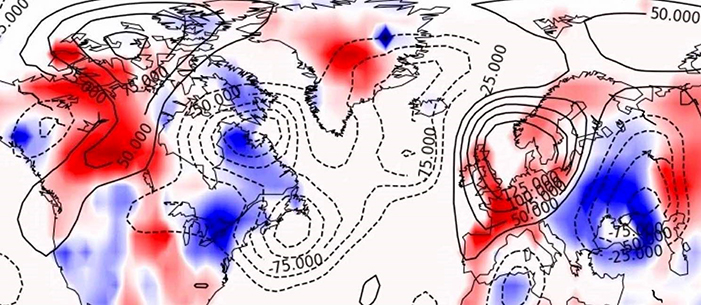Publication of the Physics Laboratory in the Physical Review Fluids on April 4, 2023. Communication of the CNRS on April 3, 2023.
Extreme heat events are rare, but have significant consequences on living beings and their environments. Anticipating their arrival is a major challenge. In an article published in Physical Review Fluids on April 4, an interdisciplinary team of French scientists, including members of the Physics Laboratory of ENS de Lyon, unveils an artificial intelligence able to predict heat waves.
Abstract
Understanding extreme events and their probability is key for the study of climate change impacts, risk assessment, adaptation, and the protection of living beings. Extreme heatwaves are, and likely will be in the future, among the deadliest weather events. Forecasting their occurrence probability a few days, weeks, or months in advance is a primary challenge for risk assessment and attribution but also for fundamental studies about processes, dataset and model validation, and climate change studies. In this work we develop a methodology to build forecasting models which are based on convolutional neural networks, trained on extremely long 8000-year climate model outputs. This approach is parallel to weather model forecasting and has complementary scopes. Because the relation between extreme events is intrinsically probabilistic, we emphasize probabilistic forecast and validation. We demonstrate that neural networks have positive predictive skills, with respect to random climatological forecasts, for the occurrence of long-lasting 14-day heatwaves over France, up to 15 days ahead of time for fast dynamical drivers (500 hPa geopotential height fields), and also at much longer lead times for slow physical drivers (soil moisture). This forecast is made seamlessly in time and space, for fast hemispheric and slow local drivers. The method is easily implemented and versatile. We find that the neural network selects extreme heatwaves associated with a north hemisphere wave-number 3 pattern. We argue that this machine learning approach should be key in the future for quantitative process studies, model intercomparisons, and dataset studies. For instance, we find that the 2 meter temperature field does not contain any new useful statistical information for heatwave forecast, when added to the 500 hPa geopotential height and soil moisture fields. The main scientific message is that most of the times, training neural networks for predicting extreme heatwaves occurs in a regime of lack of data. We suggest that this is likely to be the case for most other applications to large-scale atmosphere and climate phenomena. Depending on the information to be learned, training might require dataset lengths as long as several thousands of years, or even more, for optimal forecasting skill. For instance, using 100-year-long training sets, a regime of drastic lack of data, leads to severely lower predictive skills and general inability to extract useful information available in the 500 hPa geopotential height field at a hemispheric scale in contrast to the dataset of several thousand years long. Even with several-thousand-year-long datasets, no convergence is observed in the predictive skills coming from hemispheric geopotential height fields. We discuss perspectives for dealing with the lack of data regime, for instance, rare event simulations and how transfer learning may play a role in this latter task.

Credits: Freddy Bouchet
Reference: Probabilistic forecasts of extreme heatwaves using convolutional neural networks in a regime of lack of data. George Miloshevich, Bastien Cozian, Patrice Abry, Pierre Borgnat and Freddy Bouchet. Physical Review Fluids, April 4, 2023.
DOI: 10.1103/PhysRevFluids.8.040501






